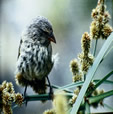|
By: Lou Jost, illustrator of Common Birds of Amazonian
Ecuador
This information was kindly submitted by www.ecuadorexplorer.com.
| Tropical Bird
Diversity | Faunal Zones of Ecuador |
| Logistics | Recommended
Birding Guides |
| Tropical Birding Strategies | Field
Identification Guides |
Tropical
Bird Diversity
 |
Most birders are aware that bird
diversity varies according to latitude. The arctic region has few
resident birds, the temperate zone has more, and the tropical belt
has the most. Half-way between the United States and the equator
is tiny Costa Rica, which has over 850 species -- more species than
in the entire United States. Ecuador, sitting right on the equator,
is the culmination of this trend:With over 1500 species of birds,
Ecuador offers more bird diversity in less space than any other
country in the world.
Geographic good fortune has blessed Ecuador with a wide variety
of faunal zones, including some of the richest on this planet, each
with its characteristic birds. Ecuador's Amazonian faunal zone alone
has more than 600 species of birds, and several other Ecuadorian
zones are nearly as rich.Ecuador's small size (equal to the U.S.
state of Colorado) and well-developed transportation system means
that this diversity can be easily accessed and experienced even
by those with limited time and money.The key to seeing lots of species
in Ecuador is to visit as many different faunal zones as possible.
However, if your goal is to observe a selection of birds closely,
you will have a more satisfying experience by picking one or two
zones and remaining there as long as.
TOP
Ecuador's
Faunal Zones
For birding purposes, Ecuador can be divided into eight faunal zones:
- Amazonian Lowlands
- Northwestern (Choco) Lowlands
- Southwestern (Tumbesin) Lowlands
- Subtropics
- Eastern Subtropics
- Temperate
- Paramo
- Galapagos Islands
These zones are largely the result
of the uplift of the Andes mountains, which separate and isolate
western Ecuador from the eastern part of the country. Additionally,
the western lowlands experience a strong moisture gradient from
south (arid) to north (very wet), causing even more diversity.
TOP
Logistics
A birding trip to Ecuador can be
cheap or expensive, depending on your degree of independence and
your required comfort level. The low-end budget traveler can take
public transportation (very cheap) to small towns near good forest.
Cheap hotels in small towns run USD 2- 3 per night, and meals about
the same. If you intend to bring your own food (there are seldom
restaurants in good forest), make sure to do your shopping ahead
of time in a big city, because the small towns are not always well
supplied of a great variety of food. At the other end of the price
scale are the Galapagos Islands and the Amazon lowlands; the best
Amazonian lodges charge USD100-150 per day (including airfare from
Quito to Coca, motor canoe transport, all meals, and a birding guide).
TOP
Recommended
Birding Guides
The birder with limited time would do well to arrange a tour with
a professional bird guide. Tropical birds can be hard to find, especially
the rare ones, and a good guide who knows bird songs can be invaluable.
Unfortunately many unqualified people call themselves bird guides.
TOP
Birding
Strategies in the Tropics
If you choose to go on your own, you can follow certain strategies
to improve your chances of seeing that once-in-a-lifetime rarity.
The most important thing is to bring a tape recorder and directional
microphone. The above equipment will cost you as little as USD 150
and yet allow you to call in many species that I guarantee you will
not see otherwise.If you can afford it, invest in a good pair of
binoculars for tropical birding.Tropical forests are dark and wet,
so you'll need binoculars with large front lenses (bigger than 40
mm in an 8x or 10x binocular) and with some water resistance."Gas-sealed"
binoculars are best; these never suffer from internal condensation,
a common problem in humid environments with cheap binoculars.One
unsettling characteristic of tropical birds is their habit of foraging
in large mixed-species flocks. This means that a birder might not
see any birds at all for a long while, and then suddenly be confronted
with forty or more species flitting around for ten minutes or so,
followed once again by silence. Tropical birding depends on finding
these flocks -- you should search hard if you hear chirping in the
distance.
TOP
Field Identification
Guides
At the moment, the best field guide for Ecuador is Birds of Colombia
by S. Hilty and W. Brown. It covers over 90% of the birds you are
likely to see in Ecuador.Common Birds of Amazonian Ecuador, Canaday
and L. Jost, (available at Libri Mundi in Quito) highlights the
50 most common birds in the Ecuadorian Amazon.The high elevations
are completely covered by Birds of the High Andes by J. Fjeldsa
and N. Krabbe.
TOP
|

